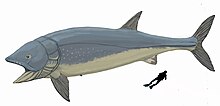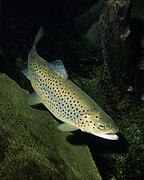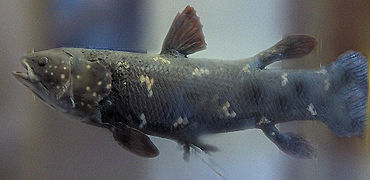Taxonomy
 Leedsichthys, of the subclass Actinopterygii, is the largest known fish, with estimates in 2005 putting its maximum size at 16 metres (52 ft).
Leedsichthys, of the subclass Actinopterygii, is the largest known fish, with estimates in 2005 putting its maximum size at 16 metres (52 ft). Fishes are a paraphyletic group and for this reason, groups such as the class Pisces seen in older reference works are no longer used in formal classifications. Traditional classification divides fish into three extant classes, and with extinct forms sometimes classified within the tree, sometimes as their own classes:[16][17]
- Class Agnatha (jawless fish)
- Subclass Cyclostomata (hagfish and lampreys)
- Subclass Ostracodermi (armoured jawless fish) †
- Class Chondrichthyes (cartilaginous fish)
- Subclass Elasmobranchii (sharks and rays)
- Subclass Holocephali (chimaeras and extinct relatives)
- Class Placodermi (armoured fish) †
- Class Acanthodii ("spiny sharks", sometimes classified under Actinopterygii) †
- Superclass Osteichthyes (bony fish)
- Class Actinopterygii (ray finned fishes)
- Clade Sarcopterygii (lobe finned fishes, ancestors of tetrapods)
The above scheme is the one most commonly encountered in non-specialist and general works. Many of the above groups are paraphyletic, in that they have given rise to successive groups: Agnatha are ancestral to Placodermi, who again have given rise to Osteichthyes, as well as to Acanthodii, the ancestors of Chondrichthyes. With the arrival of phylogenetic nomenclature, the fishes has been split up into a more detailed scheme, with the following major groups:
- Class Myxini (hagfish)
- Class Pteraspidomorphi † (early jawless fish)
- Class Thelodonti †
- Class Anaspida †
- Class Petromyzontida or Hyperoartia
- Petromyzontidae (lampreys)
- Class Conodonta (conodonts) †
- Class Cephalaspidomorphi † (early jawless fish)
- (unranked) Galeaspida †
- (unranked) Pituriaspida †
- (unranked) Osteostraci †
- Infraphylum Gnathostomata (jawed vertebrates)
- Class Placodermi † (armoured fish)
- Class Chondrichthyes (cartilaginous fish)
- Class Acanthodii † (spiny sharks)
- Superclass Osteichthyes (bony fish)
- Class Actinopterygii (ray-finned fish)
- Subclass Chondrostei
- Order Acipenseriformes (sturgeons and paddlefishes)
- Order Polypteriformes (reedfishes and bichirs).
- Subclass Neopterygii
- Subclass Chondrostei
- Class Sarcopterygii (lobe-finned fish)
- Subclass Actinistia (coelacanths)
- Subclass Dipnoi (lungfish, sister group to the tetrapods)
- Class Actinopterygii (ray-finned fish)
† – indicates extinct taxon
Some palaeontologists contend that because Conodonta are chordates, they are primitive fish. For a fuller treatment of this taxonomy, see the vertebrate article.
The position of hagfish in the phylum Chordata is not settled. Phylogenetic research in 1998 and 1999 supported the idea that the hagfish and the lampreys form a natural group, the Cyclostomata, that is a sister group of the Gnathostomata.[18][19]
The various fish groups account for more than half of vertebrate species. As of 2006,[20] there are almost 28,000 known extant species, of which almost 27,000 are bony fish, with 970 sharks, rays, and chimeras and about 108 hagfish and lampreys. A third of these species fall within the nine largest families; from largest to smallest, these families are Cyprinidae, Gobiidae, Cichlidae, Characidae, Loricariidae, Balitoridae, Serranidae, Labridae, and Scorpaenidae. About 64 families are monotypic, containing only one species. The final total of extant species may grow to exceed 32,500.[21] Each year, new species are discovered and scientifically described. As of 2016,[13] there are over 32,000 documented species of bony fish and over 1,100 species of cartilaginous fish. Species are lost through extinction (see biodiversity crisis). Recent examples are the Chinese paddlefish or the smooth handfish.
Diversity
- Agnatha
(Pacific hagfish) - Chondrichthyes
(Horn shark) - Actinopterygii
(Brown trout) - Sarcopterygii
(Coelacanth)
You received this message because you are subscribed to the Google Groups "1top-oldtattoo-1" group.
To unsubscribe from this group and stop receiving emails from it, send an email to 1top-oldtattoo-1+unsubscribe@googlegroups.com.
To view this discussion on the web visit https://groups.google.com/d/msgid/1top-oldtattoo-1/CAGNPKm%3Dz%3DcMoYmquhWhe7kvuu292WXcvZtDr0CiqhW%3Dc45S04A%40mail.gmail.com.





No comments:
Post a Comment